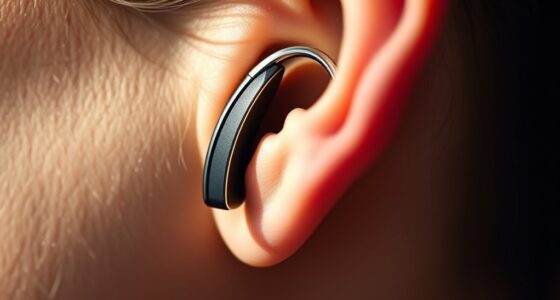Smart contact lenses let you monitor your health directly through your eyes using tiny sensors that analyze tear fluid for biomarkers like glucose or intraocular pressure. They use flexible materials, miniaturized electronics, and wireless power to provide real-time data without bulky batteries. These devices can help detect early signs of diseases like diabetes or glaucoma and even offer features like drug delivery or augmented reality. Stay with us to explore how these innovative lenses could change your health and vision.
Key Takeaways
- Smart contact lenses integrate tiny biosensors to continuously monitor biomarkers like glucose, cortisol, and intraocular pressure.
- They utilize flexible, biocompatible electronics and wireless power to provide real-time, non-invasive health data.
- Embedded drug delivery systems enable targeted treatment for eye conditions such as dry eye and glaucoma.
- Advanced materials like graphene and stretchable circuits ensure comfort, durability, and conformity to eye movements.
- These lenses support digital features like augmented reality, eye tracking, and secure data management for comprehensive health monitoring.
How Smart Contact Lenses Detect and Monitor Health Indicators
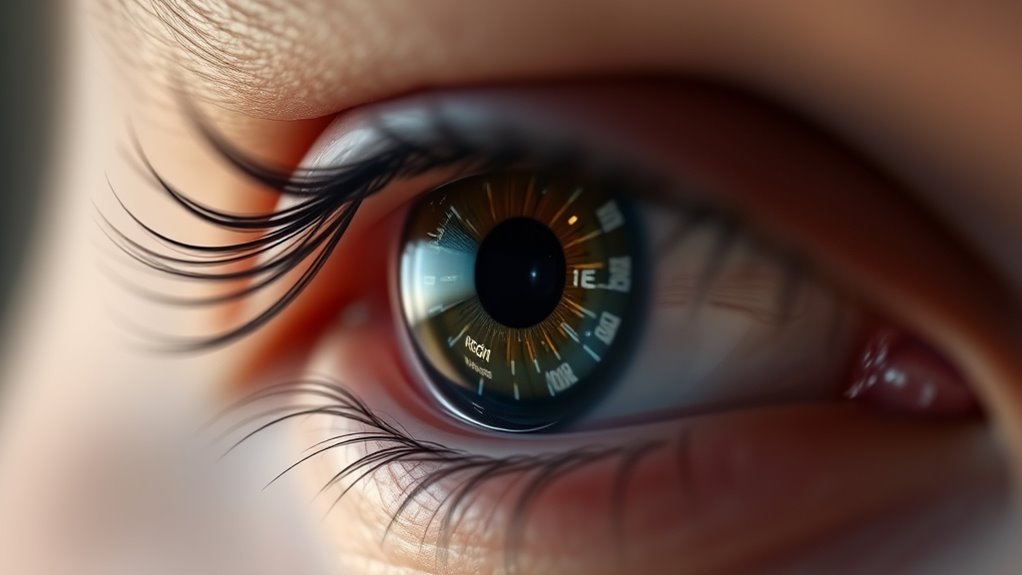
Smart contact lenses detect and monitor health indicators by integrating tiny biosensors that analyze tear fluid for key biomarkers. These advanced lenses use miniature sensors embedded within the lens material to measure biochemical signals such as glucose levels, intraocular pressure, and cortisol. Through electrochemical, optical, or capacitive sensing techniques, these biosensors convert biochemical signals into electrical data, enabling real-time monitoring of your health. The lenses often utilize wireless power to keep the sensors active without bulky batteries, ensuring unobtrusive wear. As tear fluid reflects systemic health conditions, the data collected helps identify early signs of diseases like diabetes and glaucoma. Color accuracy and contrast ratio are crucial for ensuring precise detection and clear visualization of health data on integrated displays. The integration of biomarker detection is essential for providing accurate health insights. Additionally, ongoing research aims to improve sensor durability to extend the lifespan of these lenses for continuous health monitoring. Advances in AI Security are increasingly being incorporated to protect sensitive health data transmitted by these devices, ensuring user privacy and compliance with regulations. With continuous monitoring, smart contact lenses provide a non-invasive way to keep tabs on your health throughout the day.
Key Technologies and Materials Powering Smart Lenses
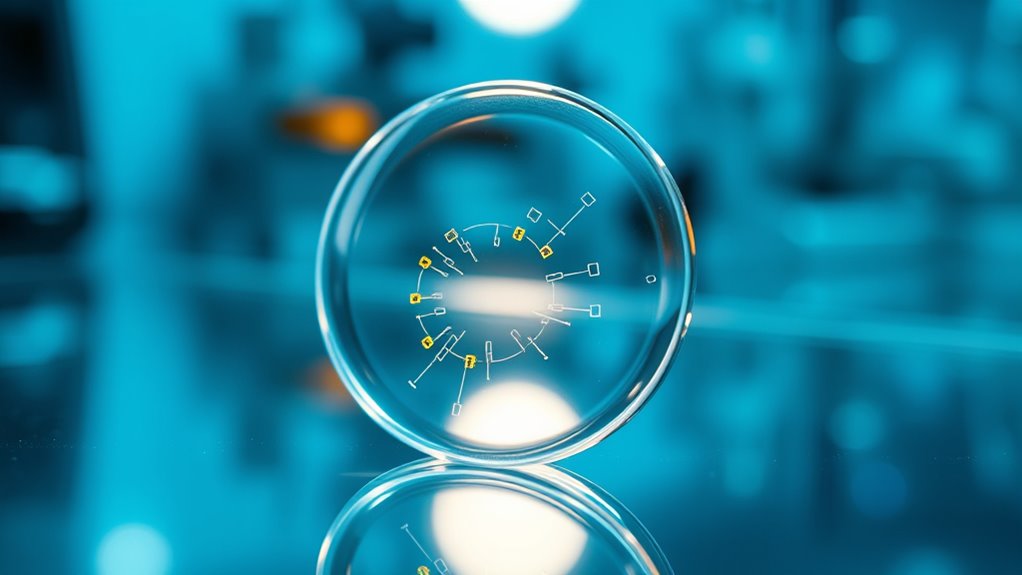
You’ll find that flexible electronic components like ultrathin circuits and sensors are vital for smart lenses, allowing them to monitor health in real time without sacrificing comfort. A forsale 100 market indicates increasing interest and development in this innovative technology. Advanced biocompatible materials, such as hydrogels and silicone, keep the lenses safe and comfortable while supporting embedded electronics. The rising popularity of Best Restaurants in various locations demonstrates how diverse and adaptable technologies can enhance user experiences. Additionally, the ongoing development of cybersecurity measures is crucial to protect sensitive health data transmitted by these devices. The integration of mental health benefits is also being explored to provide holistic well-being solutions through smart contact lenses. Together, these technologies form the foundation for seamless, functional smart contact lenses.
Flexible Electronic Components
Flexible electronic components in smart contact lenses rely on ultrathin, stretchable materials like biocompatible polymers, graphene, and metal nanowires to guarantee comfort and durability. These materials enable flexible electronics, allowing circuits to conform seamlessly to the eye’s curvature. HEPA filters are commonly used in air purifiers to effectively trap airborne particles, ensuring cleaner indoor air. Microfabrication techniques, such as laser patterning and inkjet printing, precisely integrate sensors, antennas, and circuits onto transparent substrates. This enables device miniaturization, making components ultra-thin—around 150–200 μm—so your lens remains comfortable. Key innovations include stretchable circuits that bend with your eye, wireless power transfer methods that eliminate bulky batteries, and bio-inspired adhesives for secure attachment. These materials and techniques also support biocompatibility, which is crucial for long-term use inside the eye. Advances in flexible electronics enable the development of durable, conformal components that can withstand the eye’s movements and environment. Additionally, ongoing research into material durability ensures these components can maintain performance over extended periods. Incorporating advanced manufacturing techniques further enhances the precision and reliability of these electronic components. Together, these advancements deliver durable electronic components that blend seamlessly with your eye, ensuring reliable, continuous health monitoring without sacrificing comfort.
Advanced Biocompatible Materials
You are trained on data up to October 2023. The development of biocompatible materials plays a crucial role in designing health monitoring smart contact lenses by ensuring compatibility with various nutritional components. Additionally, advancements in biocompatible materials contribute to reducing potential adverse reactions and increasing the comfort for users during extended wear. Moreover, the focus on personal resilience in emergency preparedness emphasizes the importance of adaptable solutions in health technologies. Incorporating vetted products ensures the safety and reliability of these innovative lenses for everyday use. Proper user consent management is also essential to maintain transparency and trust in health monitoring devices.
Medical Applications Transforming Eye Care and Disease Management
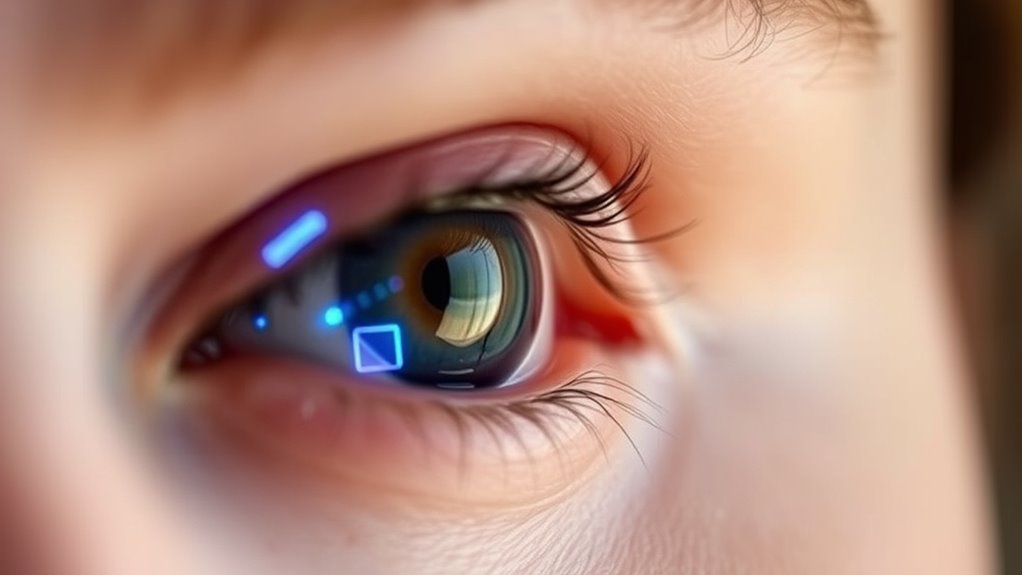
Smart contact lenses are revolutionizing eye care by enabling continuous monitoring of biomarkers like glucose and intraocular pressure, which helps catch diseases early. Additionally, integrated drug delivery systems offer targeted treatments for conditions like dry eye and allergies, making disease management more efficient. Understanding the signs and symptoms of narcissism can help in early identification and management of related health issues. Furthermore, advances in blockchain data management contribute to improved security and reliability of medical data stored within these devices. The use of sustainable and natural materials in manufacturing ensures that these innovative devices remain environmentally friendly and safe for long-term use. As the WWE Raw’s financial impact highlights the importance of revenue streams, similar strategies can enhance the affordability and accessibility of medical devices. Incorporating cost of living adjustments into device features can help ensure affordability over time, especially for users on fixed incomes.
Innovative Drug Delivery Methods
Innovative drug delivery methods via contact lenses are revolutionizing eye care by providing targeted, controlled release of medications directly onto the eye. Using embedded reservoirs, micelles, or drug complexes, these lenses enable sustained release of therapeutics, boosting therapeutic efficacy. Vetted contact lenses are carefully designed to ensure safety and effectiveness for users. Extended-wear lenses infused with drugs like ketotifen demonstrate the potential for non-invasive administration, reducing the need for drops and improving compliance. These advanced lenses address ocular diseases more effectively by minimizing drug loss from blinking and tear washout, ensuring consistent therapy. Imagine waking up to a lens that continuously delivers treatment, freeing you from frequent eye drops. You’ll experience a new level of convenience and effectiveness in managing eye conditions, transforming how you approach eye health and disease management. Additionally, understanding the regulatory standards for medical devices helps ensure these innovative lenses meet safety and efficacy guidelines. Incorporating sustained release technology into contact lenses represents a significant advancement in personalized eye care, offering tailored treatments that adapt to individual needs.
Advanced Disease Detection
Eye care is being transformed by contact lenses equipped with biosensors that detect biomarkers in tears, allowing for early diagnosis of systemic diseases like diabetes and kidney disorders. These lenses feature glucose sensors and biosensors that analyze tear biomarkers through electrochemical detection, providing rapid, sensitive disease detection.
Continuous intraocular pressure monitoring enables real-time data collection, which is vital for glaucoma monitoring and managing ocular health. By capturing tear biomarkers related to systemic diseases, smart contact lenses offer a non-invasive approach to early diagnosis and ongoing health assessment.
This technology improves disease detection accuracy, facilitates timely interventions, and reduces the need for invasive procedures, ultimately enhancing patient outcomes and advancing holistic eye and systemic health management.
Enhancing Vision and Beyond: Additional Functionalities of Smart Lenses

Enhancing vision with smart contact lenses goes beyond simple correction; these devices are now equipped with features that provide real-time information and improve daily life. You can experience augmented reality overlays for navigation, language translation, or digital annotations directly on your eye.
Some lenses include zoom capabilities activated by blinking, assisting those with low vision or detailed tasks. Advanced electronic components are integrated seamlessly, maintaining comfort and natural eye movement.
Imagine monitoring ocular health or glucose levels without invasive methods, or measuring eye pressure effortlessly. These wearable technologies leverage biomedical engineering to deliver:
- Immersive augmented reality displays for enhanced interaction
- Seamless vision correction combined with digital overlays
- Continuous monitoring of ocular health and glucose
- Drug delivery systems for targeted treatment
Challenges, Risks, and Ethical Considerations in Smart Contact Lens Use
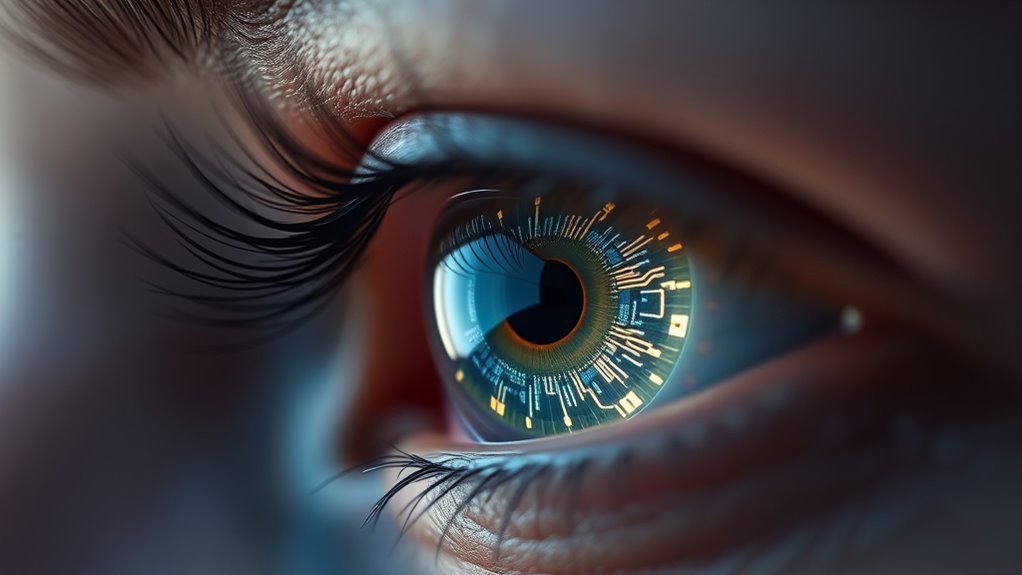
Despite the exciting potential of smart contact lenses, their widespread adoption faces numerous challenges that could hinder their integration into daily life. Cost barriers and complex regulatory approval processes slow commercialization, while issues with biocompatibility and measurement accuracy raise questions about user safety.
Overwear risks include infections, dry eye syndrome, and corneal hypoxia, especially with extended use. Data security and privacy concerns are critical, as biometric information could be vulnerable to cyberattacks or misuse.
Ethical issues also arise from surveillance and continuous recording capabilities, prompting fears over privacy and consent. Ensuring these lenses are safe, effective, and respectful of user rights requires addressing these risks and ethical considerations.
Without overcoming these hurdles, widespread adoption remains uncertain.
Future Trends and Innovations Shaping the Next Generation of Smart Lenses

Advances in microfabrication and sensor technology are paving the way for the next generation of smart contact lenses. You’ll soon experience devices with microLED displays, eye-tracking sensors, and wireless communication that create immersive augmented reality right in your eye.
Next-generation smart contact lenses feature microLED displays, eye-tracking, and wireless tech for immersive augmented reality experiences.
Future innovations focus on energy-harvesting systems like tear-based batteries and wireless transfer, enabling continuous, battery-free operation. These lenses will seamlessly combine diagnostics—such as glucose and intraocular pressure measurements—with therapeutic functions like drug delivery, all within flexible electronics that adapt to your eye.
Imagine a device that:
- Delivers real-time health insights with biocompatibility
- Uses wireless power for uninterrupted use
- Enhances your daily activities with augmented reality
- Supports continuous health monitoring and treatment
These trends promise smarter, more integrated eye care, transforming your vision of health.
Frequently Asked Questions
When Will Smart Contact Lenses Be Available?
You’re wondering when smart contact lenses will become available. Based on current trends and ongoing research, you can expect these lenses to hit the market around 2026 to 2028.
Advances in technology, regulatory approvals, and collaborations are speeding up development. While some devices like the Triggerfish® are already approved, broader health-monitoring lenses are still in trials.
However, these health-monitoring lenses are nearing commercial readiness, so stay tuned for upcoming releases.
What Are the Disadvantages of Smart Contact Lenses?
They say “every coin has two sides,” and smart contact lenses are no different. You might experience discomfort or irritation if these lenses aren’t perfectly miniaturized and biocompatible.
You could also face issues like reduced oxygen flow, leading to dryness or hypoxia. Plus, long-term safety isn’t fully known, and high costs may limit access.
These disadvantages highlight the need for careful development before widespread use.
What Does a Smart Contact Lens Do?
You might wonder what a smart contact lens does. Fundamentally, it’s a tiny device worn on your eye that uses embedded sensors and electronics to monitor your health in real-time.
It collects data from tear fluid, like glucose levels or eye pressure, and can wirelessly send this information to your device.
Some also offer features like augmented reality, helping you see or receive alerts about your health instantly.
How Much Is a Smart Contact Lens?
Imagine peering through a lens that’s like a tiny, high-tech eye, revealing the future of vision.
Right now, smart contact lenses cost between $200 and over $1,000, depending on their features. Some companies aim to make them more affordable, around $50–$100, by simplifying sensors.
But prices vary based on technology complexity, regulation, and insurance.
Expect costs to change as these innovations move from prototypes to everyday use.
Conclusion
Smart contact lenses are revolutionizing eye care, offering real-time health monitoring and enhanced vision. With over 2 billion people worldwide affected by eye conditions, these innovations could improve countless lives. By integrating advanced sensors and smart materials, you’re stepping into a future where your eyes do more—tracking health, improving sight, and empowering you. Embrace this technology, and be part of the movement transforming the way we see and stay healthy.



